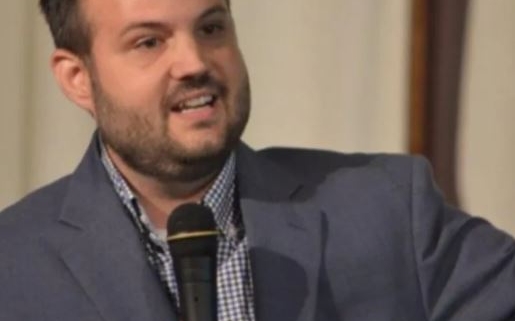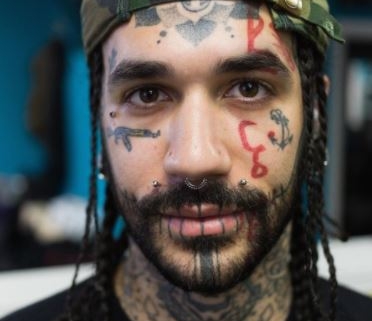-
-
Global Market Comments
May 18, 2021
Fiat LuxFeatured Trade:
(ON THE AIR WITH CASEY STUBBS),
(HOW TO HANDLE THE FRIDAY, MAY 21 OPTIONS EXPIRATION),
(UNP), (TLT)
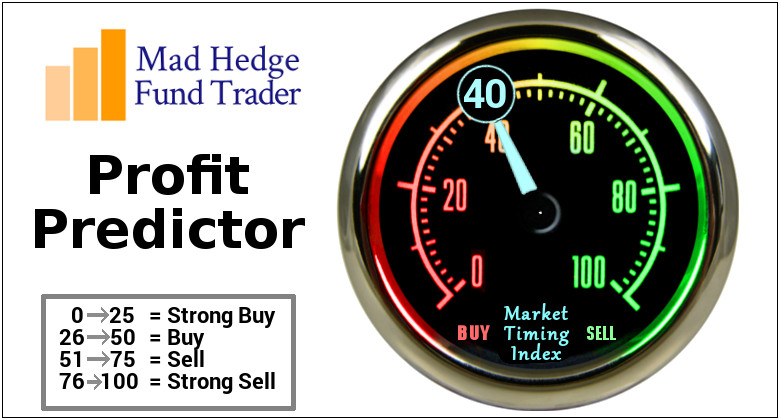
-
I managed to catch up with my buddy, Casey Stubbs, the other day. Casey assembles trading talent from all over the country with his “How to Trade It” podcasts, and my turn was up.
Am I the most interesting person Casey ever met?
Over 30 minutes, we discussed some of my favorite trading tips, investment strategies, and tricks of the trade. I touched upon how I got started in the markets a half-century ago and some of my early trading adventures. He couldn’t resist delving into my long, varied, and iconoclastic past, and I mentioned some of my greatest trades of all time.
Please enjoy. To access the podcast, please visit this link.

Podcaster Casey Stubbs
Followers of the Mad Hedge Fund Trader alert service have the good fortune to own TWO deep-in-the-money options positions that expire on Friday, May 21, and I just want to explain to the newbies how to best maximize their profits.
These involve the:
(TLT) 5/$143-$146 put spread 10.00%
(UNP) 5/$200-$210 call spread 10.00%
Provided that we don’t have another 3,000-point move down in the market by next week, these positions should expire at their maximum profit points.
So far, so good.
I’ll do the math for you on our oldest and least liquid position, the Union Pacific (UNP) May 21, 2021, $200-$210 vertical in-the-money vertical Bull Call debit spread, which I almost certainly will run into expiration. Your profit can be calculated as follows:
Profit: $10.00 expiration value - $8.70 cost = $1.30 net profit
(12 contracts X 100 contracts per option X $1.30 profit per options)
= $1,570 or 14.97% in 18 trading days.
Many of you have already emailed me asking what to do with these winning positions.
The answer is very simple. You take your left hand, grab your right wrist, pull it behind your neck, and pat yourself on the back for a job well done.
You don’t have to do anything.
Your broker (are they still called that?) will automatically use your long position to cover your short position, canceling out the total holdings.
The entire profit will be credited to your account on Monday, May 24 and the margin freed up.
Some firms charge you a modest $10 or $15 fee for performing this service.
If you don’t see the cash show up in your account on Monday, get on the blower immediately and find it.
Although the expiration process is now supposed to be fully automated, occasionally machines do make mistakes. Better to sort out any confusion before losses ensue.
If you want to wimp out and close the position before the expiration, it may be expensive to do so. You can probably unload them pennies below their maximum expiration value.
Keep in mind that the liquidity in the options market understandably disappears and the spreads substantially widen when a security has only hours, or minutes until expiration on Friday, May 21. So, if you plan to exit, do so well before the final expiration at the Friday market close.
This is known in the trade as the “expiration risk.”
One way or the other, I’m sure you’ll do OK, as long as I am looking over your shoulder, as I will be, always. Think of me as your trading guardian angel.
I am going to hang back and wait for good entry points before jumping back in. It’s all about keeping that “Buy low, sell high” thing going.
I’m looking to cherry-pick my new positions going into the next month-end.
Take your winnings and go out and buy yourself a well-earned dinner. Just make sure it’s take-out. I want you to stick around.
Well done, and on to the next trade.

You Can’t Do Enough Research
-
-
Global Market Comments
May 17, 2021
Fiat LuxFeatured Trade:
-
(MARKET OUTLOOK FOR THE WEEK AHEAD, or WHY HISTORY RHYMES),
(TLT), (SPY), (FCX), (MSFT), (DAL), (QQQ), (VIX), (DAL), (UUP) -
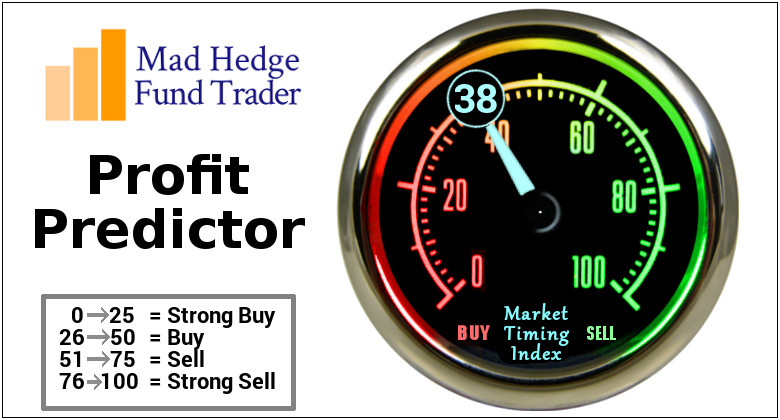
-
The 19th century humorist and writer, Mark Twain, said, “History never repeats itself, but it rhymes.” This is certainly one of those rhyming times.
Remember back in 2011 when the Dow hit a short-term peak at $12,300 in May of 2011? The Cassandras had a heyday. The bull market was over, stocks were imminently going to crash, and the next stop for the Dow was $3,000. Gold and bonds were the only safe places.
Those who drank the Kool-Aid missed the greatest investment opportunity of the century and are now driving for Uber cars to earn their crust of bread. Those who drank the Kool-Aid twice sold their homes as well ahead of the greatest real estate boom of all time.
Not that a correction wasn’t sorely needed, we needed to scare money out of what I call the “super liquidity” investments like Bitcoin, SPACS, and tech companies selling at 100 times sales with failing business models.
We also needed to put the fear of god into newbie day traders by teaching them that stocks go down as well as up. We’ve already made good progress on this front. With many of the “meme” stocks down by half or more since February, we are already making good progress on that front.
What will power the Dow to my now very prescient looking $40,000 target by yearend? The unwind of the 40-year-old bull market in bonds has barely just begun. Ten-year US Treasury bond yields ($TNX) have only appreciated from 0.32% to 1.68%, compared to 5.6% at the last 2007 peak. That means there are still many tens of trillions of dollars to shift out of bonds (TLT) and INTO STOCKS!
Once the current correction ends, money will pour back into the recent leaders, the economic cyclicals, including financials, commodities, industrials, and commodities.
Technology will stay in the penalty box for the foreseeable future until they become under-owned and cheap again. The good news here is that tech earnings are growing at such a prolific rate that the sector is losing two price earnings multiple points a month and will return to the bargain basement in the not-too-distant future.
The long term view here is that you want to rent growth, but own tech, which still has double the growth rate of everything else.
It all makes my 2021 $40,000 Dow Average target look like a piece of cake, and my 2030 goal of $120,000 positively conservative, cautious, and circumspect.
Notice that our 2,000 point-swan dive in the Dow last week lasted only three days, and then delivered the sharpest fall in the Volatility Index (VIX) in history, from $29 to $19 in only 24 hours. The writing is still on the wall. People want to BUY.
Inflation explodes, with the Consumer Price Index posting a ballistic 4.2% YOY rate, the fastest gain since 2009. The Fed believes this is a temporary surge, the markets not so much. Bonds take it on the nose. Keep selling rallies in the (TLT). We’re making a fortune here.
Volatility Index (VIX) soars to $29, almost doubling in a week. Call me when it tops $30. That’s the usual signal for a short-term stock market bottom. I’m relaxed because I’m going into this with 80% cash and have just made a huge fortune on bond shorts.
Value and cyclicals are still the Big Play. That was the message of the stock market on Friday’s wild day which saw an 11-basis point trading range in the ten-year US treasury bond. If you think the next big move in rates is up, then Cyclicals will roar, and techs will fade.
It’s all about buying what people are underweight and selling what they are overweight. I’m looking for cyclicals that have recently corrected. Stay tuned to this station.
US Inventories see solid gains as retailers load the boat for the biggest economic recovery of all time. March was up 1.3%. One of an endless series of data points pointing to the best business conditions in a century.
The Home Buying Frenzy continues, with the median price for a single-family home soaring by 16.2% to $319,200 in Q1, according to the National Association of Realtors. Record high prices are hitting all markets. The perfect upside storm continues.
Weekly Jobless Claims come in at 473,000, a new post-Covid low. Continuing claims fall to 3,655,000. The greatest economic recovery of all time continues.
Producer Prices leap in April, up 0.6% following a 1% gain in March. It is a natural follow-on from the hot CPI. The PPI tracks changes in production costs, and supply bottlenecks and shortages tied to the pandemic recovery have caused commodity prices to soar. Temporary or continuing, that is the big debate. Watch the bond market for clues.
Stanley Druckenmiller says Bonds are Toast, and The Dollar is Worse. I couldn’t agree more with my old friend and trading counterparty. Current Fed policies are now the most extreme in history and threaten the reserve status of the US dollar. Sell all rallies in the (TLT) and the (UUP).
My Ten Year View
When we come out the other side of pandemic, we will be perfectly poised to launch into my new American Golden Age, or the next Roaring Twenties. With interest rates still at zero, oil cheap, there will be no reason not to. The Dow Average will rise by 400% to 120,000 or more in the coming decade. The American coming out the other side of the pandemic will be far more efficient and profitable than the old. Dow 120,000 here we come!
My Mad Hedge Global Trading Dispatch profit reached 3.83% gain so far in May on the heels of a spectacular 15.67% profit in April. That leaves me 30% invested and 70% cash.
My 2021 year-to-date performance soared to 63.59%. The Dow Average is up 13.47% so far in 2021.
During the stock market meltdown, my hedges with shorts in the S&P 500 (SPY), NASDAQ (QQQ), and the United States Treasury Bond Fund (TLT) performed spectacularly well, leaving me up on the week. I managed to limit myself to only two stop losses, in Microsoft (MSFT) and Delta Airlines (DAL).
While everyone else was running around like chickens with their heads cut off, I was as relaxed as ever. Our worst case for May is that we will be only up single digits, instead of the double-digit gains of the past six months. That is not a bad “worst case” to have.
That brings my 11-year total return to 486.14%, some 2.00 times the S&P 500 (SPX) over the same period. My 11-year average annualized return now stands at an unbelievable 42.45%, easily the highest in the industry.
My trailing one-year return exploded to positively eye-popping 127.09%. I truly have to pinch myself when I see numbers like this. I bet many of you are making the biggest money of your long lives.
We need to keep an eye on the number of US Coronavirus cases at 33 million and deaths topping 586,000, which you can find here.
The coming week will be a weak one on the data front.
On Monday, May 17, at 9:45 AM, the New York Empire State Manufacturing Index for May will be out
On Tuesday, May 18, at 10:00 AM, the Housing Starts for April are announced.
On Wednesday, May 19 at 2:00 PM, Minutes from the last Federal Reserve FOMC Meeting are published.
On Thursday, May 20 at 8:30 AM, the Weekly Jobless Claims are published.
On Friday, May 21 at 10:00 AM, Existing Homes Sales for April are announced. At 2:00 PM, we learn the Baker-Hughes Rig Count.
As for me, we had a big 4.7 earthquake at Lake Tahoe last week. The healthy live trees vibrated and swayed. But all of the brittle dead trees killed by pine beetles during the draught snapped at the base and fell over.
Those blocked all the fire roads, so every emergency and public service organization on the lake was called up and sent up into the mountains with chain saws. That included me, a member of Lake Tahoe Search and Rescue.
I hiked up to 9,000 feet with a 50-pound load and went to work. We cut these enormous 100-foot conifers into one-foot rounds and then rolled them off the road. Everyone else on the job was under 40.
After a day of heavy lifting, I hiked down the mountain and collapsed into bed. I slept for 12 hours, which is why the Monday letter was late. They say 70 is the new 40. I am the proof of that.
So can 100 be the new 60? One can only hope.
How was your weekend?
Stay healthy.
John Thomas
CEO & Publisher
The Diary of a Mad Hedge Fund Trader


20 Year Chart of Ten Year US Treasury Yields
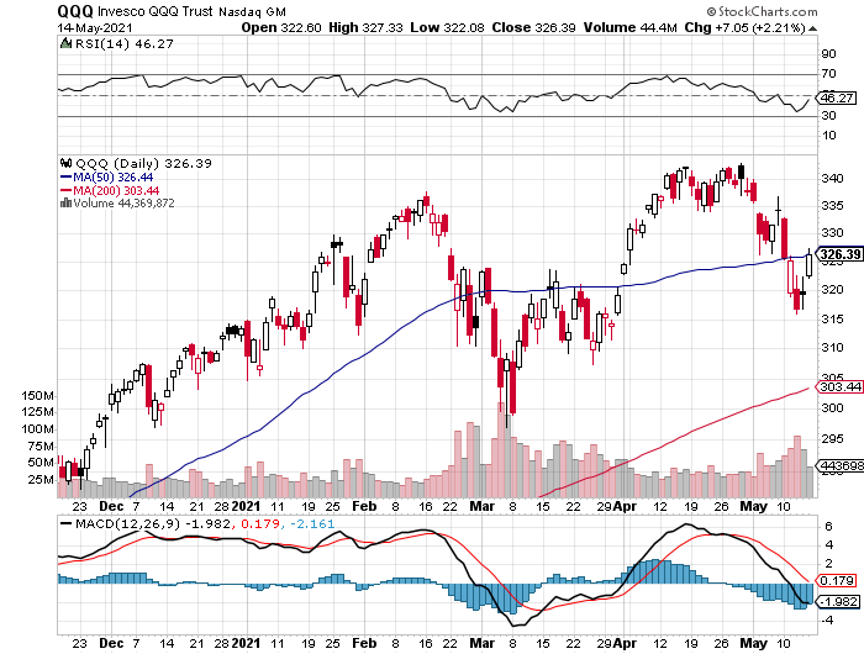
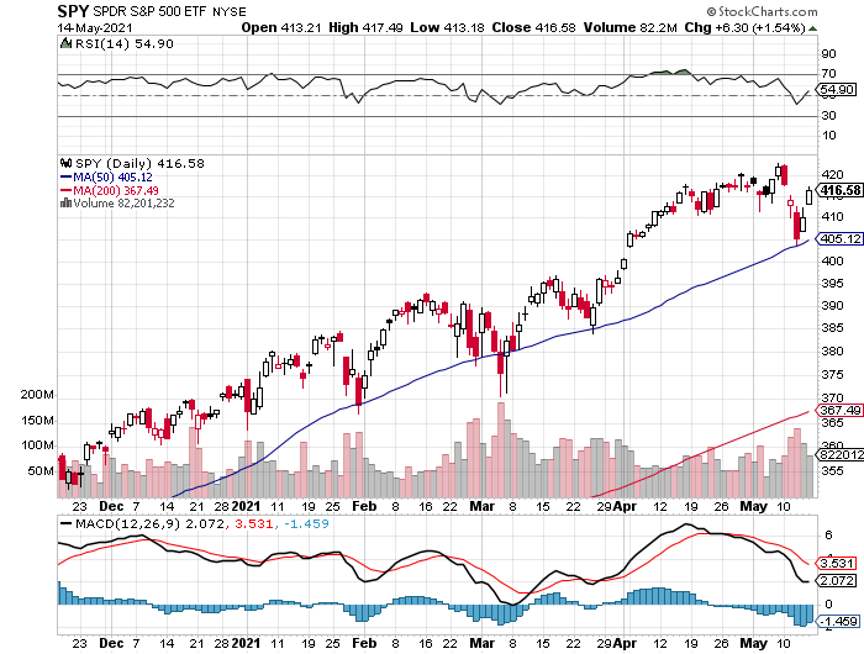

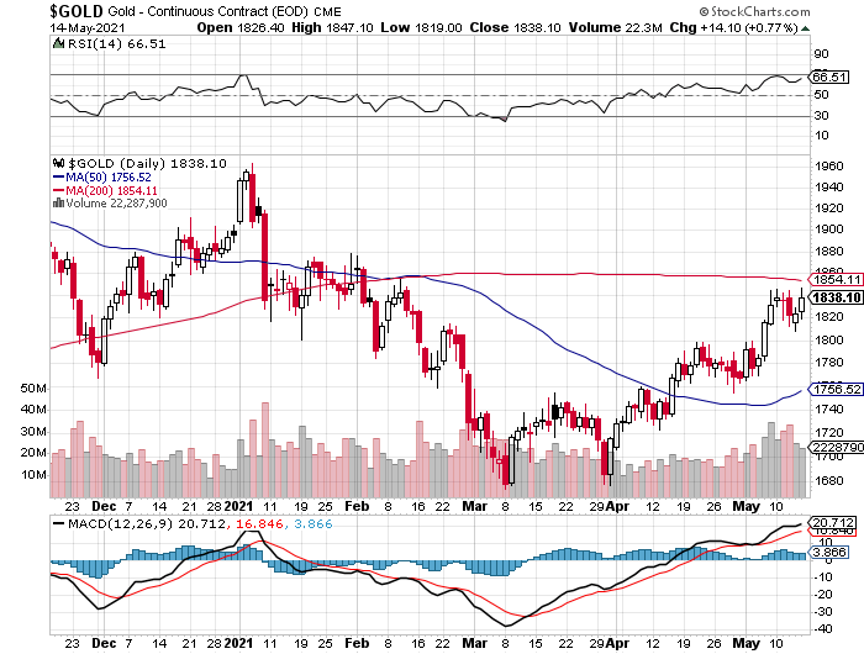
-
-
Global Market Comments
May 14, 2021
Fiat LuxFeatured Trade:
(MAY 12 BIWEEKLY STRATEGY WEBINAR Q&A),
(FCX), (QQQ), (JWN), (DAL), (MSFT), (PLTR), (V), (MA), (AXP), (UUP), (FXA), (SPWR), (FSLR), (TSLA), (ARKK), (CLX), (NIO), (EPEV), (SOX), (VIX), (USO), (XLE)

-
Below please find subscribers’ Q&A for the May 12 Mad Hedge Fund Trader Global Strategy Webinar broadcast from Lake Tahoe, NV.
Q: Is it too risky to run a double position on the US Treasury Bond Fund (TLT)?
A: Absolutely not, if anything it’s now risky enough. You need to be running triple and quadruple short positions in the (TLT) and skipping all the other marginal trades out there.
Q: Where do I find the put LEAPS recommendations?
A: If you did not get the put LEAP recommendation as part of your regular Global Trading Dispatch service, just log in to the www.madhedgefundtrader.com website and do a search on put LEAPS. Our concierge members get many more LEAPS recommendations, and they get them earlier. I happen to have an opening now, provided you can afford $10,000 a year for the service.
Q: With the inflation numbers coming at 4.2% YOY, how does that affect our strategy?
A: It kills techs, gets them too much lower levels that are much more attractive, and you make a fortune on all of your US Treasury (TLT) shorts. That's the main goal of our strategy right now. In other words, it’s great news.
Q: Would you sell technology stocks here and wait for a bounce?
A: No, ideally you would have hedged last week, buying Invesco QQQ Trust NASDAQ (QQQ) and TLT put spreads, and that hedged all your losses in your technology portfolio. The next move is to take profits on your (QQQ) and bond (TLT) shorts and then go unhedged on your tech longs. This is how hedge funds are executing their barbell strategies.
Q: Is the (TLT) $130-$135 vertical bear put spread okay for September, or should I pay more for January?
A: I would go to January because, as you noticed, this market could enter a long sideways period that goes on for months, like we just had. If you have a September and we go into another one of those sideways moves, you’re going to be wishing you did January. You don’t have to pay much more for January, only a few cents and even then, you’re looking at a 100% return.
Q: Is Tesla (TSLA) under $600 a good buy?
A: It's even a better buy at $545, which is the double bottom low of the last selloff; so, I would wait for that. And then I would essentially not do the stock, but a $450 call spread to reduce your risk even further.
Q: I just entered the Freeport McMoRan (FCX) LEAPS today. Should I average in a lower price?
A: Absolutely yes, I don't think it drops much from here since everyone expects it to double. And if you have the 8- or 20-month LEAPS, the day-to-day price move isn’t very big, given how much the stock is moving. That's the great thing about LEAPS—it reduces the volatility of your portfolio because you have such enormous time value in these long-dated LEAPS. It's really good to have a couple of these in your portfolio, just to act as a sort of sea anchor to reduce volatility; and of course, the (TLT) and (FCX) are two of the best trades out there.
Q: Would you roll a losing position?
A: I do that maybe once a year, in extraordinary circumstances. I would rather take a short-term loss on Microsoft (MSFT) and if it drops $10 more, then I go back into the position. You never know when you get one of these huge selloffs and you can take the full 10% hit on these call spreads. Remember these are highly leveraged positions; they are leverage ten to one or more. When the stock moves even a little bit against you, you don't want leverage whatsoever. Better to get out of a small hole now than a much bigger hole later. But that's just me after 52 years of trading.
Q: The hedge fund legend Stanley Druckenmiller said the current Fed monetary policy puts the US dollar at risk of losing its reserve currency status. What do you think about this?
A: I’m totally in line with him on being short the dollar and short treasuries, but I don't think the dollar will lose reserve status in my lifetime. What would they replace it with? Anything you look at has far more problems with liquidity and stability than the US dollar. I literally have been asked this many times a year for the last 50 years, ever since the US went off the gold standard in 1972. The strongest reserve currency in the world has the strongest military, and as long as that’s true, the US dollar will not lose its reserve status. That has been true since the Roman Empire. In fact, you still find Roman coins floating around.
Q: When do we stop out of Delta (DAL)?
A: When we break 43. Very simple. You break your first strike price at $43.00 and you are out of there, losing about $800 on the position, which is our hard and fast stop loss rule. Never let emotion into the equation. Stop losses should be automatic and mechanical.
Q: What do you think of Nordstrom (JWN)?
A: I think they were close to bankruptcy, but I'm looking at the higher end retailers to make a recovery. While the bricks and mortar were shut down, they did develop pretty big online businesses. That's true for Macy’s (M), Kohls (KSS) and a lot of the other businesses that survived the pandemic.
Q: Is Mastercard (MA) better than Visa (V)?
A: All three credit card companies are more or less six of one and half a dozen of the other. So, buy all three if you’re not sure. American Express (AXP) has more exposure to business travel, so if you’re looking for a business travel recovery, that's the one you want to own.
Q: Is it too late to get into (TLT) LEAPS today?
A: I think it is kind of late for the short term. We have dropped $5.00 since I put this thing out on Friday, and I would rather let it wait and fall two more points and then rally five points and then put more on. You should sell the next rally peak, wherever that is, even if we start from $130. You can even do in the money LEAPS, like a $135-$140 (TLT) going out to January—the profit on that is still well over 50%. So even today returns are very high on that position.
Q: Would you buy more Palantir (PLTR) on the recent dip?
A: Yes, but only if you have a long-term view. The CEO said he could care less about the stock price, and when CEOs say that, the stock sells off huge. If the CEO doesn't care about the stock, then nobody else does either. I think their business model is interesting for the long term and I think eventually some kind of tech rally will take it back up. That is not now.
Q: Is First Solar (FSLR) a buy?
A: We’re getting into buy territory. They had a monster 4X rally off the bottom last year. But the entire green sector got wildly overbought by February and was then dragged down with the rest of the tech selloff. I think solar is going to have a major long-term bull market. Look to buy for the long term. It’s not in call spread or LEAP territory for me yet, but it will be. Another good one to buy is SunPower (SPWR).
Q: Do you have several different subscriptions? How do I find out about them?
A: Yes, go to the www.madhedgefundtrader.com store. We have services that go from free all the way up to $10,000 a year. Just pick one that suits your level of experience, risk tolerance, and the amount of capital you have to work with.
Q: How do I get trade alerts?
A: Email customer support at support@madhedgefundtrader.com , send them your cell number and they will set you up with the trade alert service which goes straight to your phone.
Q: How do existing subscribers get a price break on your other subscriptions?
A: You make so much money trading from your existing service, that you never have to ask a price on anything again. JP Morgan once said that “If you have to ask the price of a yacht you don’t need to know.
Q: I’m doing extremely well in the Invesco Currency Shares Australian Dollar Trust (FXA) that you recommended a year ago.
A: Yes, you and everyone else who believed my story. Australia is a call option on a global economic recovery with all its commodity exports like iron ore and natural gas. My target is $100 in two years.
Q: Should I buy the US dollar (UUP) or wait for another down move?
A: I wouldn't touch it with a 10-foot pole. I think the move down in the dollar is a 10-year event that we’re one year into. By the way, currencies do go down for decades at a time because it will take that long to cut back our borrowing and start paying back some of the principle. That is a long way off.
Q: If Bitcoin drops do tech stocks drop as well?
A: I don't think there's that much of a correlation between Bitcoin and tech stocks. Tech stocks have major valuation support about 10% down and for sure 20% down. That gets you a price-earnings multiple for the big tech stocks of only 18X, which was the low in the 2008 crash and the 2000 Dotcom crash. So major historical support at an 18X multiple Bitcoin has no technical or fundamental support whatsoever because there are no fundamentals, there are only charts.
Q: Do you think Chinese carmakers like Nio (NIO) and Xpeng Inc. (XPEV) will ever catch up with Tesla?
A: No, never. China has never been able to reach the safety standards necessary to export cars to the US. They've been making electric cars in China longer than Tesla has. I was visiting electric car factories in China around 2007-2008, and they just can’t get the quality up. In the meantime, Tesla is moving ahead at warp speed, so I don't see a risk to them.
Q: I have a big position in Clorox (CLX) that I’ve made a lot of money on; should I sell it?
A: Yes, you’ll never get more reasons to buy Clorox at a great price than in a pandemic. There's actually a shortage of Clorox right now. So yes, take profits on (CLX).
Q: Would you buy Kathy Wood’s Ark Innovation ETF (ARKK) right here today?
A: No, I think we have more interest rate rallies to go and more tech selloffs to go. I would wait and buy it with ten-year US Treasury yields at 2.00%. I would rather be buying this on the way up and averaging up, than buying on the way down and averaging down.
Q: How will stocks be affected at 2.00% yields in the ten-year?
A: I think what happens is we run up 2.00%, bonds collapse, and then it stops. And when it stops and starts to pull back from 2.00%, then you get a new rally in the stock market, especially in technology stocks.
Q: Is it a good idea to hold 30-year US treasury bonds?
A: It's a terrible idea. I would be selling short US Treasury bonds up the wazoo—especially the 30 year which has the greatest price sensitivity to a move up in interest rates.
Q: Should we buy put LEAPS on oil (USO) and energy (XLE)?
A: Yes but not yet; as long as you have a red hot economy in the short term, you don’t want to be shorting anything in energy. Next year, however, may be a different story. The economic growth rate will start to slow down, oil demand starts to slow down, and the rate of replacement of gasoline cars by EV’s accelerate with all the new production. So that's next year’s trade, not this year’s trade, but it’s a good idea.
Q: When the Volatility Index (VIX) hits $30, what would be your first choices to pick up?
A: I would go for all the domestic recovery, interest rate, and industrial plays that have been working so well this year. They will continue to lead the market until we get a major reversal down in interest rates.
Q: When do I buy semiconductor stocks (SOX)?
A: When the rest of tech bottoms out and starts its way back up. It’s better to average up than average down.
To watch a replay of this webinar with all the charts, bells, whistles, and classic rock music, just log in to www.madhedgefundtrader.com, go to MY ACCOUNT, click on GLOBAL TRADING DISPATCH, then WEBINARS, and all the webinars from the last ten years are there in all their glory.
Good Luck and Stay Healthy
John Thomas
CEO & Publisher
The Diary of a Mad Hedge Fund Trader

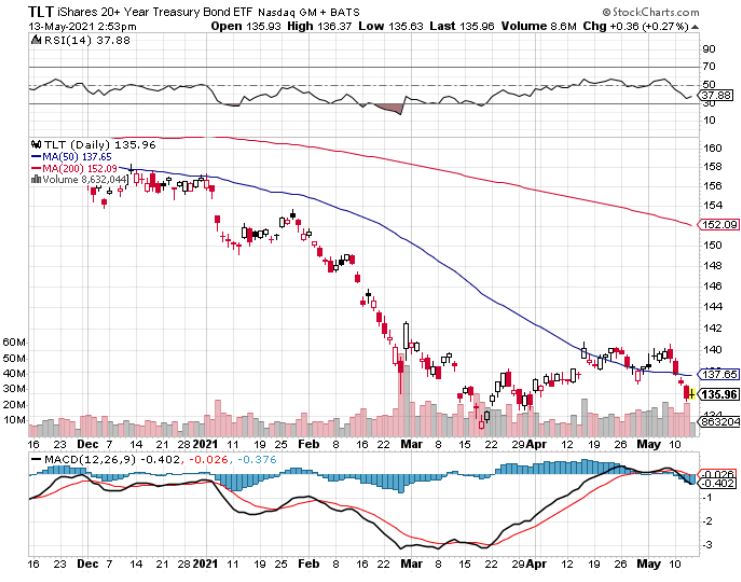
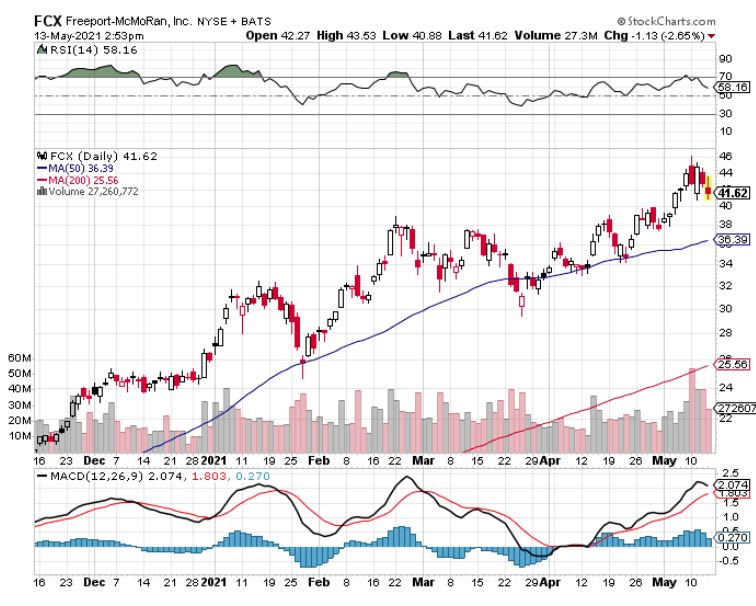
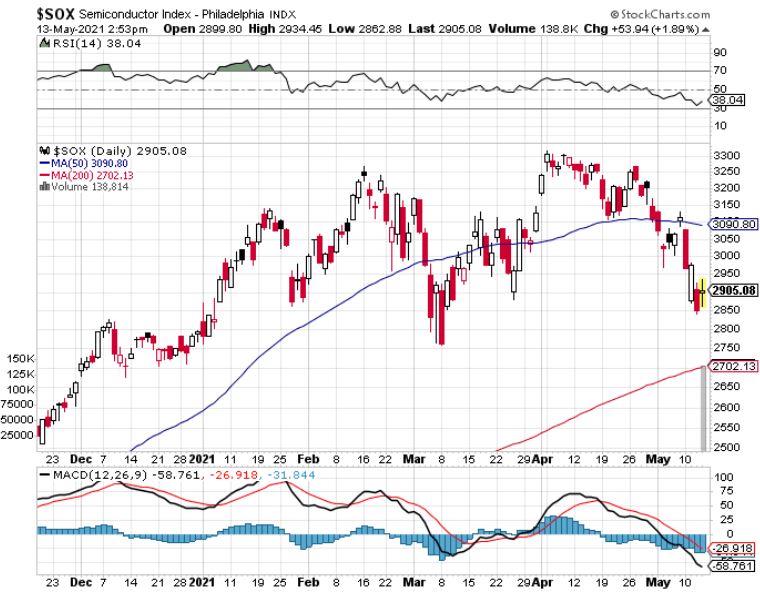
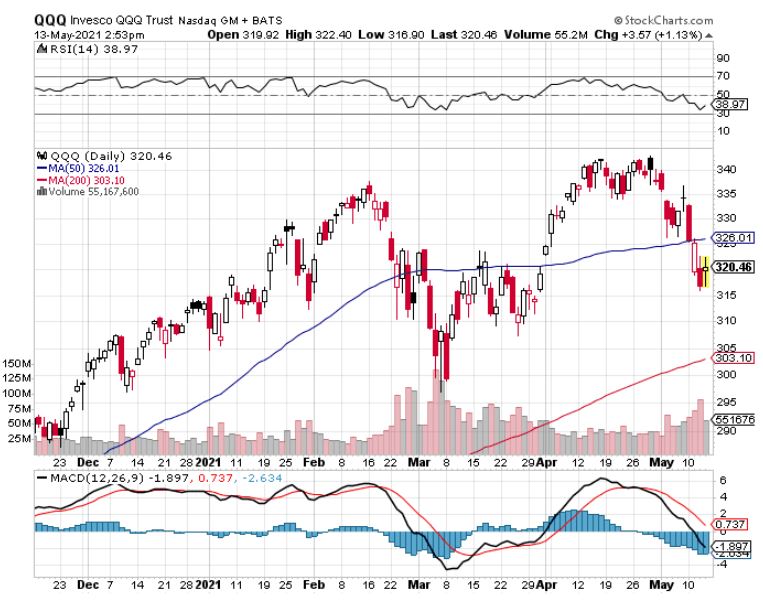
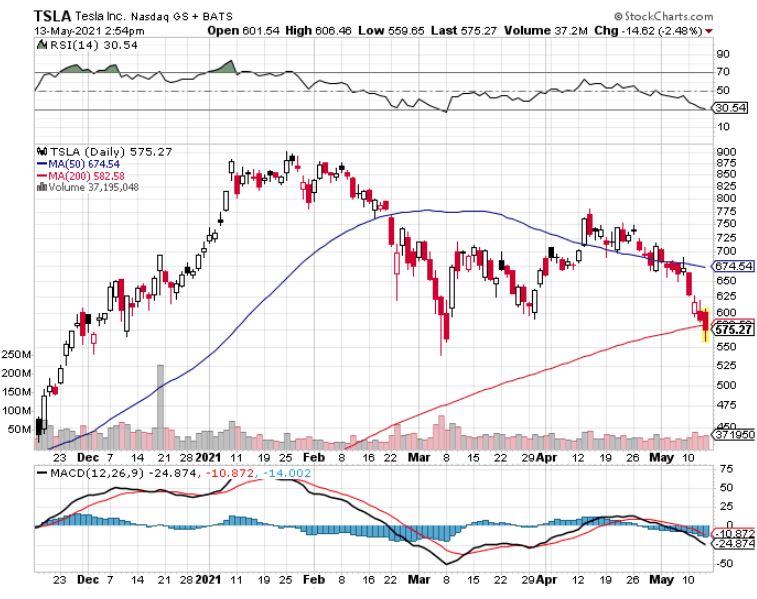
“Send us your freaks,” said an Amazon human resources executive
to a temp agency during its early days.
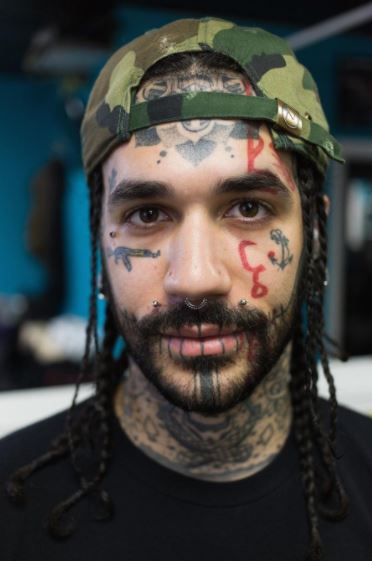
-
-
Global Market Comments
May 13, 2021
Fiat LuxFeatured Trade:
-
(LEVERAGING UP WITH THE “COPPER SHOCK”)
(FCX), ($COPPER)
-
If you’re wondering what to buy on this dip, take a very hard look at Freeport McMoRan (FCX) LEAPS.
We are getting to the point where great equity trades with potentially huge returns are becoming few and far between. At the very least, they are only a fraction of the opportunities we saw a year ago, which was a once-in-a-century event.
So, when your trade of the century runs out, what do you do?
You find another trade of the century!
It just so happens I have another such animal.
You are all well aware of the cyclical bull market in base commodities and the coming “copper shock.”
How would you like to make a ton of money on this, a lot more, like three times more?
I have been dealing in the front-month options so far and managed to catch a 10X move in the shares of Freeport McMoRan (FCX). I think (FCX) shares could double from here. Here is how to maximize your profits.
Simply extend your maturities and lower your strike prices through LEAPS, or Long-Term Equity Anticipation Securities.
I’ll show you how to do that, first with a conservative position, and then a much more aggressive one. Better yet, an excellent entry point for both positions is close.
The case for higher copper prices is overwhelming.
Sounds like a great long to me.
Currently, LEAPS are listed for the (FCX) all the way out until January 20, 2023.
However, the further expiration dates will have far less liquidity than near-month options, so they are not a great short-term trading vehicle. That is why entering limit orders in LEAPS only, as opposed to market orders, is crucial.
These are really for your buy-and-forget investment portfolio, defined benefit plan, 401k, or IRA.
Because of the long maturities, premiums can be enormous. However, there is more than one way to skin a cat, and the profit opportunities here can be astronomical.
Like all options contracts, LEAPS gives its owner the right to "exercise" the option to buy or sell 100 shares of stock at a set price for a given time.
LEAPS have been around since 1990, and trade on the Chicago Board Options Exchange (CBOE).
To participate, you need an options account with a brokerage house, an easy process that mainly involves acknowledging the risk disclosures that no one ever reads.
If LEAPS expires "out-of-the-money" by the expiration date, you can lose all the money you spent on the premium to buy it. There's no toughing it out waiting for a recovery, as with actual shares of stock. Poof, and your money is gone.
Note that a LEAPS owner does not vote proxies or receive dividends because the underlying stock is owned by the seller, or "writer," of the LEAPS contract until the LEAPS owner exercises.
Despite the Wild West image of options, LEAPS are actually ideal for the right type of conservative investor.
They offer vastly more margin and more efficient use of capital than traditional broker margin accounts. And you don’t have to pay the usurious interest rates that margin accounts usually charge.
And for a moderate increase in risk, they present hugely outsized profit opportunities.
For the right investor they are the ideal instrument.
So, let’s get on with my specific examples for the (TLT) to discover their inner beauty.
By now, you should all know what vertical bull call debit spreads are. If you don’t, then please click here for my quickie video tutorial (you must be logged in to your account).
Warning: I have aged since I made this video.
Today, the (FCX) is trading at $42.86
The cautious investor should buy the (FCX) January 2022 $45-$50 vertical bull call debit spread for $1.65. Some 60 contracts get you a $10,000 exposure. This is a bet that (FCX) will rise above $50 in eight months. Sounds like a total no-brainer, doesn’t it?
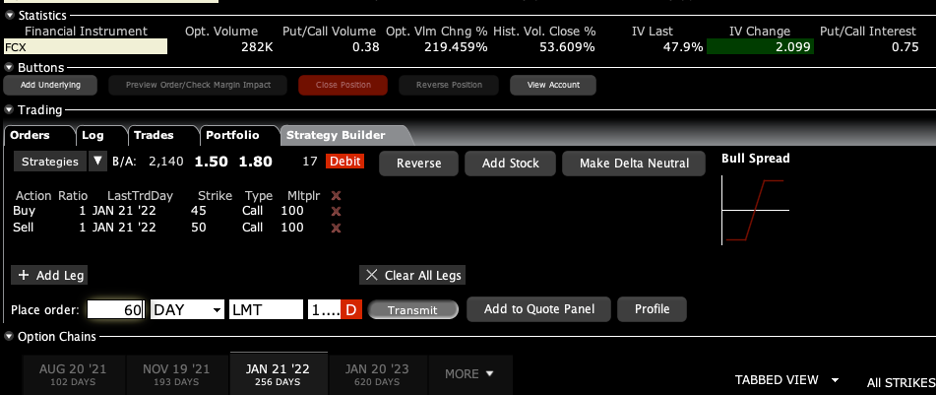
expiration date: January 21, 2022
Portfolio weighting: 10%
Number of Contracts = 60 contracts
Here are the specific trades you need to execute this position:
Buy 60 January 2022 (FCX) $45 calls at………….………$7.00
Sell short 60 January 2022 (FCX) $50 calls at……….…$5.40
Net Cost:………………………….………..………….…..............$1.60
Potential Profit: $5.00 - $1.60 = $3.40
(60 X 100 X $3.40) = $20,400 or 104% in eight months. In other words, your $10,000 investment turned into $20,400 with an almost sure thing bet.
This is a bet that the (FCX) will stay above $50 by the January 21 option expiration in eight months.
Let’s say that you’re so convinced that exploding copper prices will cause the (FCX) to crash again that you’re willing to take on more risk and place a bigger bet.
Here is your dream trade:
Buy the (FCX) January 2023 $55-$60 vertical bull call debit spread for $1.00. Some 100 contracts get you a $10,000 exposure. This is a bet that (FCX) will rise above $60 in 20 months.
That’s what you would expect to see during a normal economic recovery. This is the greatest economic recovery of all time.
expiration date: January 20, 2023
Portfolio weighting: 10%
Number of Contracts = 100 contracts
Here are the specific trades you need to execute this position:
Buy 100 January 2023 (FCX) $55 calls at…………...………$7.50
Sell short 100 January 2023 (FCX) $60 calls at…..………$6.50
Net Cost:………………………….………..………….…................$1.00
Potential Profit: $5.00 - $1.00 = $4.00
(100 X 100 X $4.00) = $40,000 or 50.00% in 20 months. In other words, your $10,000 investment turned into $40,000 with an almost sure thing bet.
This is a bet that the (FCX) will stay above $60.00 by the January 20, 2023 options expiration in 20 months.
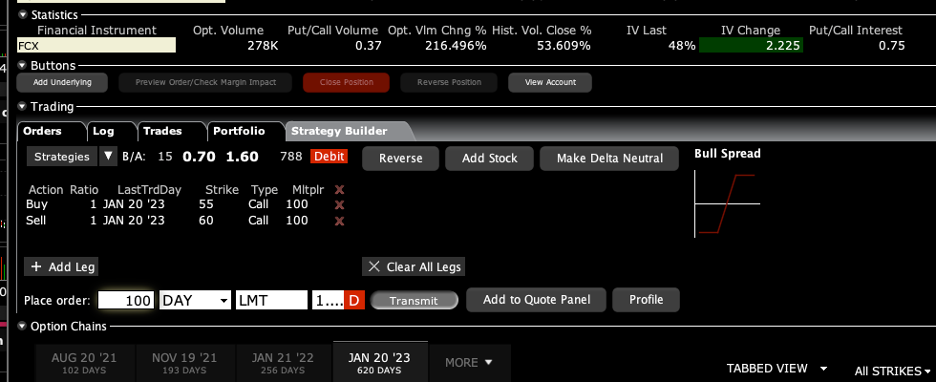
Why do a call spread instead of just buying the $50 calls outright?
You need a much bigger upside move to make money on this trade. By paying only $1.60 instead of $6.00 for a position you can quadruple your size, from 15 to 60 contracts for a $10,000 commitment. That quadruples your upside leverage on the most probable move in the (FCX), the one from $45 to $50.
That’s what real hedge funds do all day long, find the most likely profit and leverage up on it like crazy.
Let’s do the math on the two positions. If you buy the (FCX) January 2022 $45-$50 vertical bull credit spread for $1.60, you reach a maximum value of $5.00 on expiration day at $50.
If you buy the (FCX) January 2022 $50 calls outright, at $50 on expiration day your position is worth zero, nada, bupkiss. It gets worse. To make the same amount of profit as the spread the (FCX), or $20,400, it has to rise all the way to $53 to break even. Below that, you make more money than the spread, but at a quarter the rate.
How could this trade go wrong?
There is only one thing. We get a new variant on Covid-19 that overcomes the existing vaccines and brings a fourth wave in the pandemic.
In this case the (FCX) doesn’t rocket to $60 but collapses to $20 or more. We go back into recession. Both of the above positions go to zero. But if we get a fourth wave, you are going to have much bigger problems that your options positions.
So there it is. You pay you money and take your chances. That why the potential returns on these simple trades are so incredibly high.
Enjoy.
John Thomas
CEO & Publisher
The Diary of a Mad Hedge Fund Trader
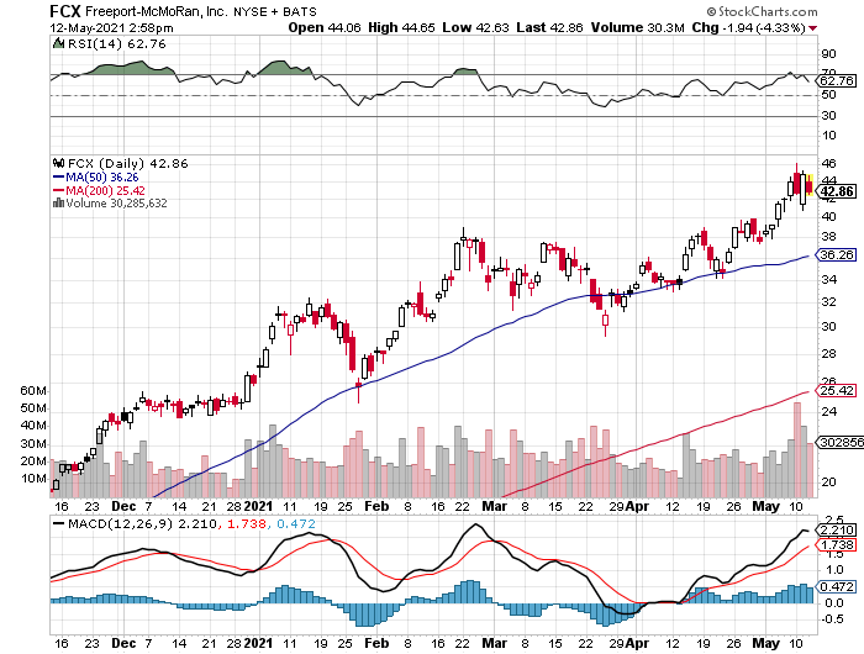
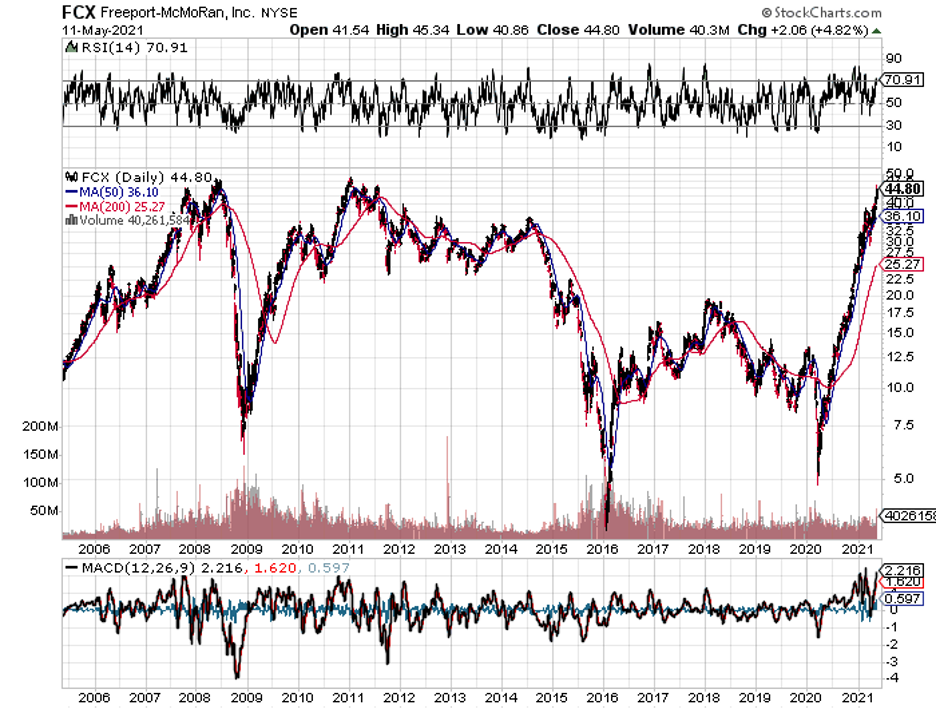
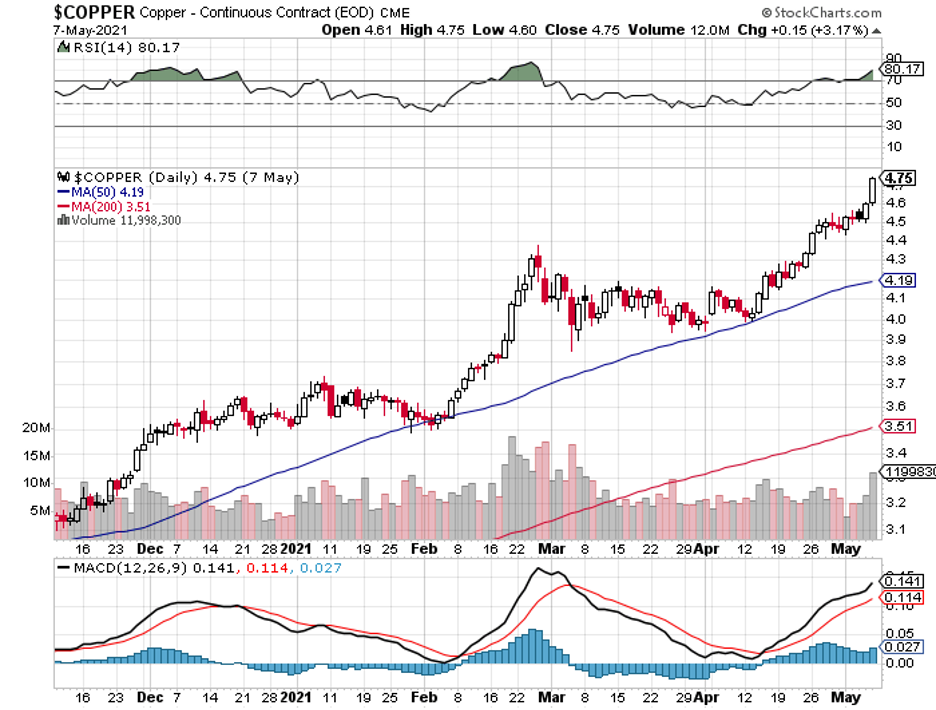

And She’s Still on Her Learner’s Permit
Legal Disclaimer
There is a very high degree of risk involved in trading. Past results are not indicative of future returns. MadHedgeFundTrader.com and all individuals affiliated with this site assume no responsibilities for your trading and investment results. The indicators, strategies, columns, articles and all other features are for educational purposes only and should not be construed as investment advice. Information for futures trading observations are obtained from sources believed to be reliable, but we do not warrant its completeness or accuracy, or warrant any results from the use of the information. Your use of the trading observations is entirely at your own risk and it is your sole responsibility to evaluate the accuracy, completeness and usefulness of the information. You must assess the risk of any trade with your broker and make your own independent decisions regarding any securities mentioned herein. Affiliates of MadHedgeFundTrader.com may have a position or effect transactions in the securities described herein (or options thereon) and/or otherwise employ trading strategies that may be consistent or inconsistent with the provided strategies.

